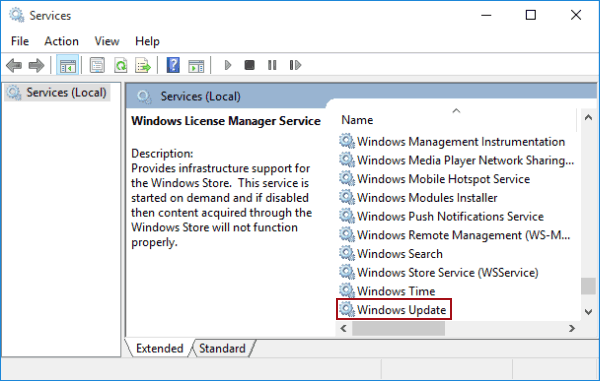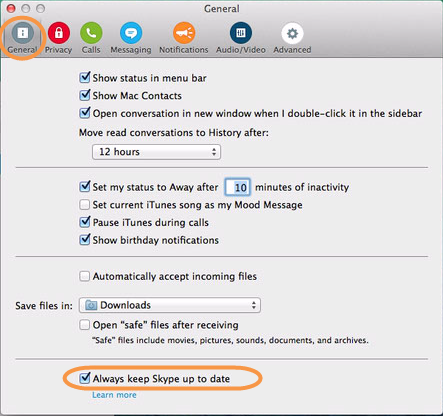Microsoft Turn On Automatic Updates Mac Stop
- May 18, 2016 Discuss: Stop Windows 10 from automatically updating your PC Sign in to comment. Be respectful, keep it civil and stay on topic. We delete comments that.
- There are two download types: Manual: Ad-hoc download with minor enhancements and/or minor bug fixes. Download from the Download Center or when instructed by our Support team. Prompted: Important download with useful feature enhancements and/or critical bug fixes.It will download automatically or prompt the user to download when there is no meeting in-progress.
- Microsoft Turn On Automatic Updates Mac Stops
- Cannot Turn On Automatic Updates
- Turn On Automatic Updates Xp
- Microsoft Turn On Automatic Updates Mac Stop Auto
- Mac Turn Off Auto Update
Background app downloads work the same as any other background download. Apple looks for opportunities to grab the updated bits from the server in a way that impacts you the least. So, if they do their job right, you shouldn't even notice the bits coming down while you work, watch, or while your Mac power naps.
If you get tight on space, Apple will also intelligently remove an unused installer — which can be reclaimed at any time from the cloud — so it doesn't impact your storage.
Dec 03, 2019 On Mac, you can try to change the Chrome auto update URL to disable the updates. Open Finder and go to “Applications” folder. Right click or control + click on the Google Chrome folder and go to “Show Packaged Content”. Click “Contents” folder and open “Info.plist” file. Dec 13, 2018 How to disable automatic updates for Microsoft Office. To stop getting updates and features for Office on Windows 10, use these steps: Open. Here's how to stop your Mac nagging you about macOS updates and how to stop updates happening automatically. Remind Me Tomorrow, or Turn on Auto Update.
In other words, it lets the Mac work the way iPhone, iPad, and Apple TV have been working for a while.
If you want to make sure background app download is on, or you hate the idea and want to make sure it's off, you can do that in your Mac App Store preferences.
How to turn on — or turn off — automatic app update downloads on your Mac
- Launch the Mac App Store on your Mac.
- Click on App Store in the menubar.
- Click on Preferences in the dropdown menu.
Check the box to the left of Automatic updates.
To disable background updates, repeat the same process and uncheck the box.
Should I leave Automatic Updates on?
If you hate waiting for app updates to download, then yes. That way, whenever you want to update, it'll be ready and waiting for you. Apple will never install an update without your express permission — or action! — but it'll make sure you don't have to wait when you want to install it.
If you have limited bandwidth or you don't want to update to newer versions of an app — for example if you're running a production system and need to wait for apps or drivers to update first — then no. Leave it unchecked and only download when you're sure you really want to.
Any questions?
Not sure about updates? Drop your questions in the comments below!
macOS Catalina
Main
For all your USB-C needsMicrosoft Turn On Automatic Updates Mac Stops
The HybridDrive is a USB-C dock with an SSD built in
You need more ports, right? And you probably need more storage, right? What you really need is the HybridDrive.
-->Cannot Turn On Automatic Updates
Note
Office 365 ProPlus is being renamed to Microsoft 365 Apps for enterprise. For more information about this change, read this blog post.
Symptoms
By default, installations of Microsoft Office are configured to automatically update your Office installation when new updates are made publicly available. However, if you examine the Account section of the backstage, you may see that updates are disabled or that the command to manage updates is disabled or hidden. For example, the following figure indicates that updates are disabled in the backstage.
Cause
This issue occurs if updates have been manually disable or are managed through Group Policy settings.
Resolution

We recommend that you keep automatic updating enabled for Office installations because this configuration allows Office to automatically update with the latest fixes and security features. To re-enable automatic updates for Office, follow the steps below.
Manually configure automatic updates
If your Office installation is not managed by Group Policy, you can manually re-enable automatic updates by following these steps. If you cannot follow these steps because the Update Options control is disabled or missing, your updates are being managed by Group Policy.
- Start any program.
- On the File tab, select Account.
Note: In Outlook, select Office Account. - On the right side, select Update Options, and then select Enable Updates.
- If you are asked whether you want to let Microsoft Office make changes to your computer, select Yes.
Automatic updates managed by Group Policy
Warning
Follow the steps in this section carefully. Serious problems might occur if you modify the registry incorrectly. Before you modify it, back up the registry for restoration in case problems occur.
If you cannot follow the steps in the 'Manually configure automatic updates' section, this is because the Update Options control is disabled or missing due to a Group Policy. For example, the following figure shows the Update Options control when the Enable Updates option is hidden through a Group Policy:
To examine the registry data that is associated with the Group Policy settings which control this feature, follow these steps:
- Start Registry Editor. To do this, take one of the following actions:
- In Windows 10 or Windows 8, press the Windows key + X, select Run, type regedit in the Open box, and then press Enter.
- In Windows 7 and Windows Vista, select Start, type regedit in the Start Search box, and then press Enter. If you are prompted for an administrator password or for confirmation, type the password, or select Allow.
- Locate and then select the following registry key:
Note: If this key does not exist in your Registry Editor, see How to add the registry key via policy below.
Sep 05, 2018 Install Windows apps directly with CrossOver and use a Windows app like any other native Mac App; There are advantages and disadvantages to each, but that last one – installing Windows apps.
 Sep 21, 2017 Question: Q: how to open microsoft windows application files on my mac. I WANT TO OPEN WINDOWS APPLICATION FILES ON MY MAC. IN INFO IT READS MICROSOFT APPLICATION, ON NON ISO COMPUTERS IT USED TO OPEN AS FLASH FILES. Question: Q: how to open microsoft windows application files on my mac More Less. Apple Footer. This site contains user. Apr 06, 2019 How to access Microsoft Remote Desktop on your Mac by Conner Forrest in Software on June 25, 2018, 7:54 AM PST If you need to access Windows applications through your Mac, a remote desktop. Jan 15, 2016 How to run Windows applications on a Mac, without installing Windows. If you only need to run a few specific Windows application on your Mac, then you might not need to go to the expense or hassle.
Sep 21, 2017 Question: Q: how to open microsoft windows application files on my mac. I WANT TO OPEN WINDOWS APPLICATION FILES ON MY MAC. IN INFO IT READS MICROSOFT APPLICATION, ON NON ISO COMPUTERS IT USED TO OPEN AS FLASH FILES. Question: Q: how to open microsoft windows application files on my mac More Less. Apple Footer. This site contains user. Apr 06, 2019 How to access Microsoft Remote Desktop on your Mac by Conner Forrest in Software on June 25, 2018, 7:54 AM PST If you need to access Windows applications through your Mac, a remote desktop. Jan 15, 2016 How to run Windows applications on a Mac, without installing Windows. If you only need to run a few specific Windows application on your Mac, then you might not need to go to the expense or hassle.Microsoft 365 Apps for enterprise, Office 2019, and Office 2016
HKEY_LOCAL_MACHINEsoftwarepoliciesmicrosoftoffice16.0commonOfficeUpdate
Office 2013
HKEY_LOCAL_MACHINEsoftwareWow6432Nodemicrosoftoffice15.0commonOfficeUpdate
- Examine the following registry values under the OfficeUpdate key:
- DWORD: EnableAutomaticUpdates
Values:
0 = automatic updates are disabled
1 = automatic updates are enabled - DWORD: HideEnableDisableUpdates
Values:
1 = hide the menu option to enable or disable automatic updates
0 = show the menu option to enable or disable automatic updates
- If you have any questions or concerns about these policy settings, see your domain administrator.
How to add the registry key via policy
The registry key is added automatically when you install ADMX/ADML files. Microsoft remote desktop mac error code 0x4. To do this:
Microsoft 365 Apps for enterprise, Office 2019, and Office 2016
- Always download the LATEST admin templates to a location of your choice:Administrative Template files (ADMX/ADML) and Office Customization Tool for Microsoft 365 Apps for enterprise, Office 2019, and Office 2016
- Select the Download button.
- Select either the x64 or the x86 build.
- Select Run and follow the prompts to install the software.
- Copy the *.admx files into the C:/Windows/PolicyDefinitions/ folder.
- Copy the *.adml files from the language-locale subfolder (for instance, 'en-US') into the respective language-locale folder under C:/Windows/PolicyDefinitions/.
Turn On Automatic Updates Xp

Warning
Be sure to preserve the same language-locale PolicyDefinitions folder which is applicable to your environment.
Office 2013
- Go to the Office 2013 Administrative Template files (ADMX/ADML) and Office Customization Tool page.
- Select the Download button.
- Select either the x64 or the x86 build.
- Select Run and follow the prompts to install the software.
- Copy the *.admx files into the C:/Windows/PolicyDefinitions/ folder.
- Copy the *.adml files from the language-locale subfolder (for instance, 'en-US') into the respective language-locale folder under C:/Windows/PolicyDefinitions/.
Warning
Be sure to preserve the same language-locale PolicyDefinitions folder which is applicable to your environment.
After you copy the Administrative Template files to AD DS, you'll find the update policy settings under Computer Configuration > Policies > Administrative Templates > Microsoft Office 2016 (Machine) > Updates in the Group Policy Management Console. You'll also find a description of how to configure each policy setting.
Microsoft Turn On Automatic Updates Mac Stop Auto
More information
Mac Turn Off Auto Update
For more information about configuring the update settings via GPO, see Configure update settings for Microsoft 365 Apps for enterprise.